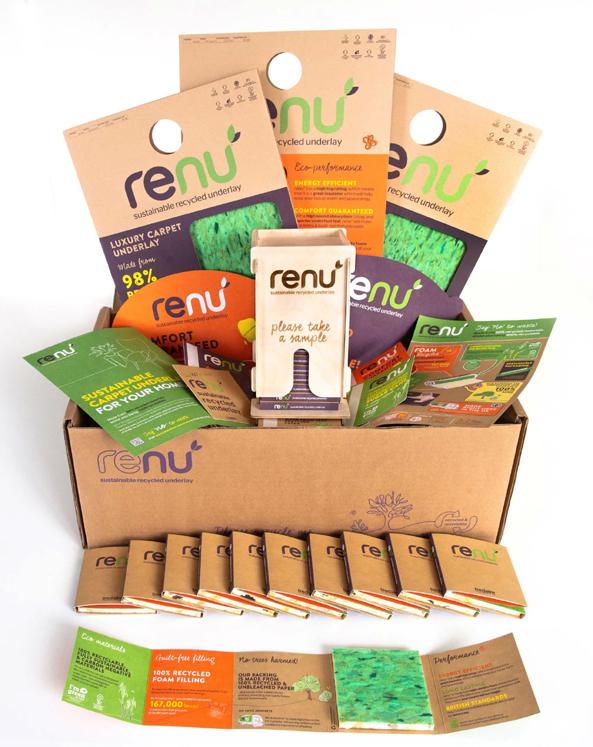
4 minute read
Underlay
Stocklists: Flooring Fact Sheet from Interfloor Flooring factsheet Eco-friendly underlay Sustainable underlay Interfloor ‘Says NO to Waste’
renu® is a game changer. Interfloor’s new underlay meets the concerns of our modern world in reducing waste and being environmentally sustainable. It’s made by bringing together raw materials that we save from going to landfill with some that have a positive effect on the environment.
The in-store sales support available to renu® stockists renu® is a sustainable, recycled carpet underlay and is without question the most sustainable underlay in Interfloor’s long history. We have used post-consumer waste, car tyres and plastic bottles in the manufacture of our underlay for many years. But with renu® we have gone even further responding to the aspiration for a fully sustainable product. It’s made from 98% recycled materials, using ethically sourced and genuinely recycled materials, which means keeping waste from going to landfill and is 100% recyclable itself! The main body of the underlay is made of foam reclaimed from recycled soft furnishings, this foam is them mixed with a binding agent and subjected to high temperature steam under high pressure. The backing is made from 100% recycled and unbleached paper and we use vegetable-based inks for printing. The facing film is made from an ethically produced, carbonnegative bio-based film made from sugar cane. The sugar cane actively captures CO2 from the atmosphere whilst at the same time releasing oxygen – making this material not just green, but proactively green. Let’s not forget, the point of underlay is that it feels great and prolongs the life of a new carpet and renu®, being made from highdensity foam and with a renu® stockists will be included in the online stockist thickness of 9mm, is suitable locator on the for all areas of the home. Interfloor website.
For more information visit www.interfloor.com/renu
Flooring factsheet
Underlay
In a tight market for margins, underlay for carpet and hard flooring offers retailers one of the best opportunities to add value to every sale – with good profitability, trade-up potential once benefits are understood and high customer satisfaction levels.
The Carpet Foundation and its Consumer Code of Practice approved by the Trading Standards Institute (TSI) recommend that new carpet underlay is bought with every new carpet. Many consumers are now aware of the benefits of underlay but more needs to be done to provide information about the different types available and their suitability for different areas of the home. Setting up in-store demonstrations so customers can walk on samples with different grades of underlay and feel the difference has shown excellent results. Some manufacturers offer point-of-sale units and foot testers.

Benefits
Good underlay will...
•Improve underfoot comfort • Increase appearance retention, reducing flattening • Absorb the pressure of foot traffic and reduce wear • Improve thermal insulation and warmth • Increase sound insulation • Smooth out sub-floor imperfections • Last the lifetime of the carpet
Poor or old underlay will...
•Feel hard and unwelcoming • Reduce carpet life • Cause wrinkling and premature wear spots • Cause carpet fibres to break down more quickly • Not meet British Standards
How thick?
A maximum of 12mm is recommended (working with gripper will be difficult thereafter) but rooms with heavy traffic will need a thinner, denser pad. The combination of thickness and density is all important as a thick underlay with low density may not perform well. Typically, the thicker the underlay, the better quality it will need to be – 11mm is often used for luxury installations with 9mm and 7mm the common domestic thickness.
Sponge rubber Crumb
Combination PU foam
Types
PU (polyurethane) foam
This is now the market’s most popular underlay and is typically made from recycled foam offcuts. The foam provides excellent comfort and performance levels with lots of thickness options and densities and provides great insulation – and its light weight helps handling.
Sponge rubber
Introduced in the 1950s, this is a more traditionally manufactured underlay available in flat or waffle patterns in a wide range of weights for different applications. It performs well for comfort and has a durable spring retention.
Crumb rubber
Flat and dense, crumb rubber is good for heavy footfall – offering maximum protection but a little less comfort (and very good over stair nosings).
Laminate underlay
There’s still an opportunity to sell underlay with laminate flooring, improving the acoustic performance of the floor and helping the boards float above any imperfections in the sub-floor.
Combination
A rubber crumb base with a felt top layer offers a good combination of protection, durability and comfort. It also allows carpet with seaming to bed into the top felt.
Underfloor heating underlay
Always ask if there is underfloor heating. Most manufacturers offer specialised products. Underlay and carpet with a combined tog rating of 2.5 can be used – which means the underlay would normally have a tog rating of 1.0.
Felt
This traditional (but environmentally friendly) undelay is made from recycled fibres – wool, jute and synthetic – to create a firm, dense pad with excellent thermal insulation. Still a very popular choice among contractors when stretch fitting woven carpets.
Pre-tackified underlay
A self-adhesive single stick underlay in both needlefelt and PU. A removable system for heavy use when comfort is desired.
www.interfloor.com
www.floorwise.co.uk
www.carpenterunderlay.co.uk
www.underlay.com
www.wilsons-carpet-underlays.co.uk
www.qaflooringsolutions.com



